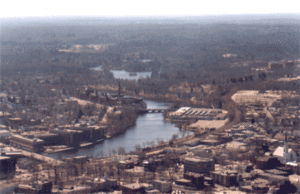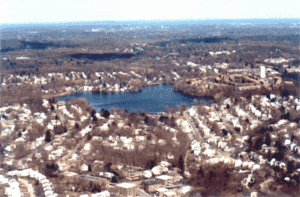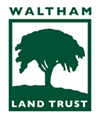Historic water site landscapes in Waltham
Charles River
Named for King Charles I by John Smith in 1614, the river was tidal up to Gerry's Landing in Cambridge. Fish were plentiful, and Native Americans maintained fishing weirs along the river in Watertown and Waltham. The first mill was built along the river in Watertown in 1637 by Matthew Craddock et al. In 1788, John Boies built a dam across the river and built a paper mill, just east of the current Moody Street. In 1794, Gov. Gore built a paper mill on his estate, and in 1801, Nathan Upham built a paper mill at the mouth of Stony Brook. In 1813, Francis Cabot Lowell started the first water-powered mill in the country to combine all of the manufacturing processes for textile production under one roof. From this date on, Waltham's character changed from an agricultural to an industrial community.
Hardy Pond
Originally named the Great Pond in the Woods, this pond has changed names (and owners) over the centuries to from Mr. Samuel's Pond, to Fiske's, Sherman's, Mead's and Hardy Pond. Surrounded by wetlands, and adjacent to Stearns Hill, this pond had been much deeper in the past. An extended family of Nipmucs regularly camped along the western shore prior to European settlement, and continued to return there well into the 19th century. A lovely pine grove on the northern shore, called Wellington's Grove, was a favorite picnic site for 19th century Pond Enders, Trapelonians and Kite Enders, who watched Independence Day fireworks over the pond. The Hardy Pond Association has been active in lobbying and planning for the restoration and dredging of the pond, a project still underway.
Beaver Brook
Beginning on the other side of Route 95 in Lexington, this major stream winds through North Waltham and across Main Street, and empties into the Charles River near Newton Street. Beaver Brook is joined by Chester Brook, Clematis Brook and other smaller streams between Beaver Street and Linden Street. In 1631-32, Governor John Winthrop led an exploratory expedition up the Charles River and along Beaver Brook, which he named for the many beaver dams he encountered along the brook. In 1662, Timothy Hawkins sold 3/4 acre to Thomas Agar for the purpose of erecting a fulling (preparation of wool cloth) mill near the cascades at the current site of Beaver Brook Reservation. This site has been the location of several different mills through the 19th century, including Plympton's satinet mill (which burned down in 1849) and Kendall's flour mill. Beaver Brook and its mills were the subject of a poem, entitled "Beaver Brook," by James Russell Lowell.
Chester Brook
Beginning at Hardy Pond, this significant waterway runs along Lexington Street and Beaver Street. Sometime before 1690, Thomas Rider erected a grist mill on the west side of the brook, near the current Grassfield's Restaurant. In the 18th century, the mill went to Moses Mead, who ran a mill for manufacturing finely tooled woodenware implements. Moses Mead's mill was Waltham's first industry. Further downstream, Deacon Thomas Livermore built in 1731 a grist mill along Chester Brook, near the current Lyman estate.
Stony Brook
Fed by numerous other streams and beginning in Weston, Stony Brook runs through Waltham near the Weston boundary, crosses under Route 20 and empties into the Charles River at the Newton boundary, south of Brandeis University. In 1801, Nathan Upham erected a paper mill at the mouth of Stony Brook, along the Charles River.
Read more about Water Sites, Wetlands, Woods and Hills.
